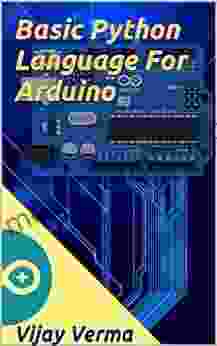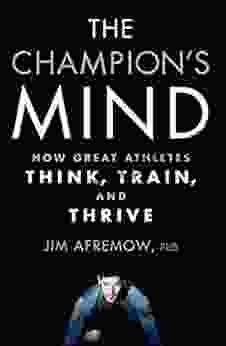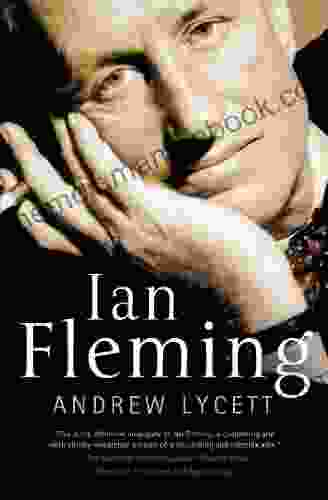A Comprehensive Guide to Python for Arduino: Unlocking the Power of Embedded Systems

Python is a versatile and powerful programming language that is increasingly popular for embedded systems development. Embedded systems are small, computerized devices that are designed to perform specific tasks, such as controlling the temperature of a room or controlling the motion of a robotic arm.
4.8 out of 5
| Language | : | English |
| File size | : | 2430 KB |
| Text-to-Speech | : | Enabled |
| Enhanced typesetting | : | Enabled |
| X-Ray for textbooks | : | Enabled |
| Word Wise | : | Enabled |
| Print length | : | 109 pages |
| Lending | : | Enabled |
| Screen Reader | : | Supported |
Python is well-suited for embedded systems development because it is easy to learn, has a wide range of libraries and modules available, and is cross-platform compatible. This means that you can develop your Python code on any operating system and then deploy it to any embedded system that supports Python.
Getting Started with Python for Arduino
To get started with Python for Arduino, you will need the following:
- An Arduino board
- A USB cable
- The Arduino IDE
- The Python for Arduino library
Once you have all of the necessary components, you can follow these steps to get started:
- Install the Arduino IDE.
- Install the Python for Arduino library.
- Connect your Arduino board to your computer using the USB cable.
- Open the Arduino IDE and create a new sketch.
- Copy and paste the following code into the sketch:
import time
# Create an instance of the Arduino object arduino = Arduino()
# Set the digital output pin to 13 (the LED on the Arduino board) arduino.set_pin_mode(13, arduino.OUTPUT)
# Turn on the LED arduino.digital_write(13, arduino.HIGH)
# Wait for 1 second time.sleep(1)
# Turn off the LED arduino.digital_write(13, arduino.LOW)
- Click the "Upload" button to upload the code to your Arduino board.
- Once the code has been uploaded, the LED on your Arduino board will turn on and off.
Benefits of Using Python for Arduino
There are several benefits to using Python for Arduino development, including:
- Ease of use: Python is a relatively easy language to learn, even for beginners. This makes it a great choice for embedded systems development, as you don't need to have a deep understanding of programming to get started.
- Wide range of libraries and modules: Python has a large and active community, which has developed a wide range of libraries and modules for a variety of tasks. This means that you can easily find libraries to help you with tasks such as reading sensors, controlling motors, and communicating with other devices.
- Cross-platform compatibility: Python is cross-platform compatible, which means that you can develop your code on any operating system and then deploy it to any embedded system that supports Python. This makes it easy to develop code for a variety of different embedded systems.
Examples of Python for Arduino Projects
There are many different projects that you can build with Python for Arduino, including:
- Temperature monitoring: You can use Python to read the temperature from a sensor and then display it on an LCD screen.
- Motion detection: You can use Python to detect motion using a PIR sensor and then trigger an alarm.
- Motor control: You can use Python to control the speed and direction of a motor.
- Communication: You can use Python to communicate with other devices using serial communication or I2C.
Python is a powerful and versatile programming language that is well-suited for embedded systems development. Its ease of use, wide range of libraries and modules, and cross-platform compatibility make it a great choice for beginners and experienced developers alike.
If you are interested in learning more about Python for Arduino, there are a number of resources available online. The Arduino website has a number of tutorials and examples, and there are also a number of books and online courses that can teach you how to use Python for embedded systems development.
4.8 out of 5
| Language | : | English |
| File size | : | 2430 KB |
| Text-to-Speech | : | Enabled |
| Enhanced typesetting | : | Enabled |
| X-Ray for textbooks | : | Enabled |
| Word Wise | : | Enabled |
| Print length | : | 109 pages |
| Lending | : | Enabled |
| Screen Reader | : | Supported |
Do you want to contribute by writing guest posts on this blog?
Please contact us and send us a resume of previous articles that you have written.
 Top Book
Top Book Novel
Novel Fiction
Fiction Nonfiction
Nonfiction Literature
Literature Paperback
Paperback Hardcover
Hardcover E-book
E-book Audiobook
Audiobook Bestseller
Bestseller Classic
Classic Mystery
Mystery Thriller
Thriller Romance
Romance Fantasy
Fantasy Science Fiction
Science Fiction Biography
Biography Memoir
Memoir Autobiography
Autobiography Poetry
Poetry Drama
Drama Historical Fiction
Historical Fiction Self-help
Self-help Young Adult
Young Adult Childrens Books
Childrens Books Graphic Novel
Graphic Novel Anthology
Anthology Series
Series Encyclopedia
Encyclopedia Reference
Reference Guidebook
Guidebook Textbook
Textbook Workbook
Workbook Journal
Journal Diary
Diary Manuscript
Manuscript Folio
Folio Pulp Fiction
Pulp Fiction Short Stories
Short Stories Fairy Tales
Fairy Tales Fables
Fables Mythology
Mythology Philosophy
Philosophy Religion
Religion Spirituality
Spirituality Essays
Essays Critique
Critique Commentary
Commentary Glossary
Glossary Bibliography
Bibliography Index
Index Table of Contents
Table of Contents Preface
Preface Introduction
Introduction Foreword
Foreword Afterword
Afterword Appendices
Appendices Annotations
Annotations Footnotes
Footnotes Epilogue
Epilogue Prologue
Prologue Crystal Senter Brown
Crystal Senter Brown Lynn Painter
Lynn Painter Nicholas Bjorn
Nicholas Bjorn Joan Macleod
Joan Macleod Elvio Cipollone
Elvio Cipollone William Matthews
William Matthews Robert F Burgess
Robert F Burgess Philip G Altbach
Philip G Altbach Roger Staiger
Roger Staiger Jo Bell
Jo Bell Phyllis L Fagell
Phyllis L Fagell Alison Edwards
Alison Edwards S A Beck
S A Beck Marianne Sunderland
Marianne Sunderland Simone De Beauvoir
Simone De Beauvoir Minister Mike Abbruzzi
Minister Mike Abbruzzi Andrew Hallam
Andrew Hallam Anne Stuart
Anne Stuart Jarrod Musick
Jarrod Musick Merih Taze
Merih Taze
Light bulbAdvertise smarter! Our strategic ad space ensures maximum exposure. Reserve your spot today!

 Ernest HemingwayAn In-Depth Analysis of Constantinian Religious Policy: Unraveling the Impact...
Ernest HemingwayAn In-Depth Analysis of Constantinian Religious Policy: Unraveling the Impact...
 Arthur C. ClarkeThe Ghost in the Shell: The Human Algorithm 30: An Uncanny Exploration of...
Arthur C. ClarkeThe Ghost in the Shell: The Human Algorithm 30: An Uncanny Exploration of... Isaac AsimovFollow ·19.1k
Isaac AsimovFollow ·19.1k Wade CoxFollow ·3.1k
Wade CoxFollow ·3.1k Elton HayesFollow ·5.2k
Elton HayesFollow ·5.2k Matthew WardFollow ·16.5k
Matthew WardFollow ·16.5k Chuck MitchellFollow ·14.1k
Chuck MitchellFollow ·14.1k Jamie BlairFollow ·4.5k
Jamie BlairFollow ·4.5k Adrian WardFollow ·16.6k
Adrian WardFollow ·16.6k Harry CookFollow ·7.1k
Harry CookFollow ·7.1k

 Robert Browning
Robert BrowningGeorge Gershwin's "Love You Porgy" from Porgy and Bess: A...
George Gershwin's "Love You Porgy" is an...

 Gary Reed
Gary ReedFitness Exercise Motivation and Goals: Build Lean Muscle...
Embark on a...

 Terence Nelson
Terence NelsonEat More, Train Less, and Get Lean: The Mr. America...
In today's fast-paced world, achieving a...

 J.D. Salinger
J.D. SalingerThe Mystical Poetry of the Wise Magi: Interpreting the...
In the realm of...

 Blake Bell
Blake BellStep By Step Instructions To Maximize Cryptocurrency...
Cryptocurrency...
4.8 out of 5
| Language | : | English |
| File size | : | 2430 KB |
| Text-to-Speech | : | Enabled |
| Enhanced typesetting | : | Enabled |
| X-Ray for textbooks | : | Enabled |
| Word Wise | : | Enabled |
| Print length | : | 109 pages |
| Lending | : | Enabled |
| Screen Reader | : | Supported |










